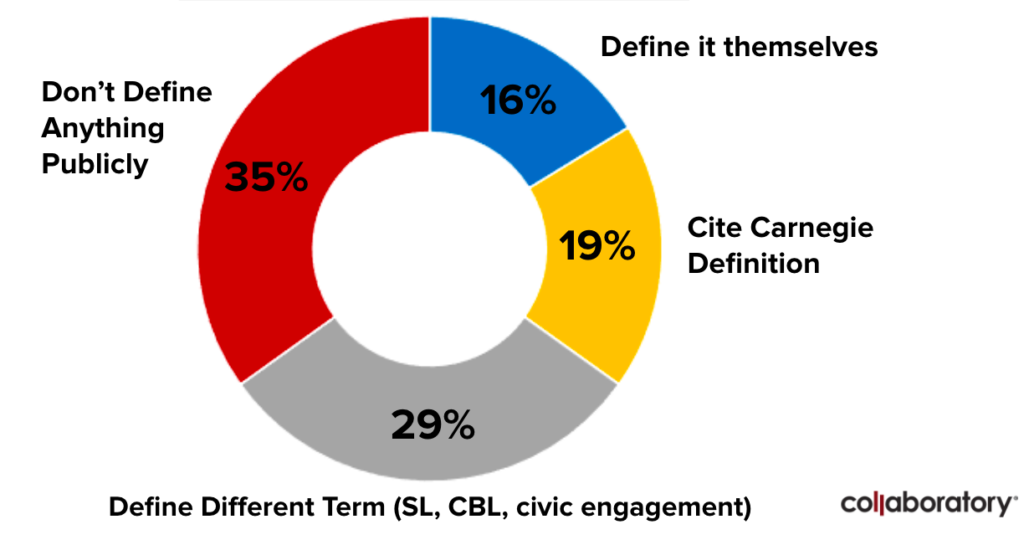In order to meaningfully collect, track, and assess community engagement data, institutions must first identify how their campus defines or identifies community engagement or other similar terms (e.g., civic engagement, community-based learning). Defining community engagement is important for an institution. Not doing so invites a proliferation of terms to describe engagement, contributing to a “scattered” institutional and image (Janke & Medlin, 2015) and leaving institutions strained to articulate their mission and purpose as it relates to community engagement. Conversely, a common articulation of engagement implies a united movement and advances the strategic alignment of engagement with institutional priorities (Barker, 2004).
When setting out to collect and understand their institution’s community engagement data, administrators are met with a multitude of questions, such as:
- What counts as community engagement? And what doesn’t?
- How is engagement enacted on campus and in the community?
- Should we include other related terminology within our definition (e.g., civic engagement, public service)?

A review of the website of each institution within the Collaboratory network (N = 43) revealed that there is much variance in terms of where they are in the process of defining community engagement across the entire institution. The Collaboratory network represents a diverse group of institutions across the country, 47% of which hold the Carnegie Foundation’s Elective Classification for Community Engagement.
While 35% of institutions within the Collaboratory network do not publicly define community engagement (or a related term), 35% do publicly define community engagement – either choosing to define it themselves, or cite and/or adapt the Carnegie Foundation’s definition. 29% of Collaboratory institutions have publicly defined a related term, such as social embeddedness, civic engagement, public engagement, etc.
For institutions that have chosen to define community engagement themselves, expand upon the Carnegie Foundation definition, or define a different term, examples of such definitions are highlighted in the table below.
The Carnegie Foundation for the Advancement of Teaching defines community engagement as the collaboration between institutions of higher education and their larger communities (local, regional/state, national, global) for the mutually beneficial creation and exchange of knowledge and resources in a context of partnership and reciprocity.
The purpose of community engagement is the partnership (of knowledge and resources) between colleges and universities and the public and private sectors to enrich scholarship, research, and creative activity; enhance curriculum, teaching, and learning; prepare educated, engaged citizens; strengthen democratic values and civic responsibility; address critical societal issues; and contribute to the public good.
(Carnegie Foundation for the Advancement of Teaching, 2022)
What Campuses are Doing | Examples of Definitions | Self-defining “community engagement” – with a focus on operationalizing the term | “Community engagement is faculty and student work that integrates sustained, reciprocal engagement with the public and helps transform [institution’s] mission to support the co-creation, co-dissemination, co-preservation and co-application of knowledge for the betterment of society.”
|
|---|---|
Self-defining “community engagement” – with a focus on partnerships and engagement outcomes | “Collaborative relationships and partnerships that connect, educate, and engage people and organizations throughout our network.” |
Self-defining “community engagement” – with a focus on student engagement | “Community engagement is applying what you’re learning in the classroom to the community, and using lessons from the community to enrich your coursework. It could be volunteering at a local non-profit, taking a course where you develop a plan for an organization, helping your club offer a program at a local library, or interning at a local business.” |
Self-defining “community engagement” – identifying various types of engagement | Community engagement is the process of collaborating with members of one or more “communities” to meet the goals or needs of community stakeholders.
Communities can be defined geographically, socially, economically, or by using other parameters. The engagement process employs at least one of the methods below, listed in order from most reactive to community needs to the most proactive. Direct service; Self help
Education; Community-Based Participatory Research; Policy Making; Advocacy; Direction action (community organizing) |
Citing, then expanding upon the Carnegie definition of “community engagement” | The “community” in community engagement is not defined by sector, such as private or public, for-profit or nonprofit; rather, community is broadly defined to include individuals, groups, and organizations external to campus that use collaborative processes for the purpose of contributing to the public good.”
|
Defining a related term – “social embeddedness” | Social Embeddedness: Universities are anchor institutions that must serve as pillars of the community, committed not only to student success, but also to the success of their geographic areas they serve. [institution] does this by actively participating in innovative knowledge networks, and collaborating in mutually beneficial partnerships with individuals and organizations across the community who share our vision. |
Defining a related term – “civic engagement” | Civic engagement occurs when individuals work to make a change on a local, state, national, and international level through political and non-political actions. The goal of community and civic engagement is to address public concerns and uplift communities. |
Defining a related term – “public engagement” | Public engagement is the partnership of university knowledge and resources with those of the public and private sectors to enrich scholarship, research, and creative activity; enhance curriculum, teaching and learning; prepare educated, engaged citizens; strengthen democratic values and civic responsibility; address critical societal issues; and contribute to the public good. |
Establishing a campus-wide definition of community engagement, or similar terminology, is an incredibly important – yet daunting – task! If your institution is working to define community engagement or building capacity to do so, we invite you to explore additional resources shared in the April 2002 webinar, Campus, Community, and Community Engagement Context, offered within Collaboratory’s larger Carnegie webinar series.
References
Barker, D. (2004). The scholarship of engagement: A taxonomy of five emerging practices. Journal of Higher Education Outreach and Engagement, 9(2), 123–137.
Janke, E. M., & Medlin, K. D. (2015). A centralized strategy to collect comprehensive institution-wide data from faculty and staff about community engagement and public service. Metropolitan Universities Journal, 26(2), 125-146.
Collaboratory Can Help!
Defining community engagement, or related terminology, is an important step institutions must take in order to effectively collect and leverage engagement data on their campuses. Collaboratory assists institutions navigate the internal processes and structures to advance this important work, through data.
If you are interested in leveraging Collaboratory to assist your institutions’ efforts to define and track your community engagement, please email info@cecollaboratory.com to learn more.
